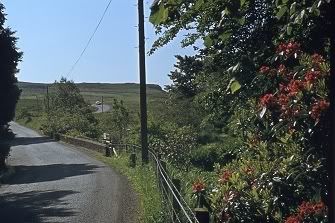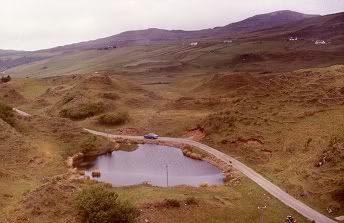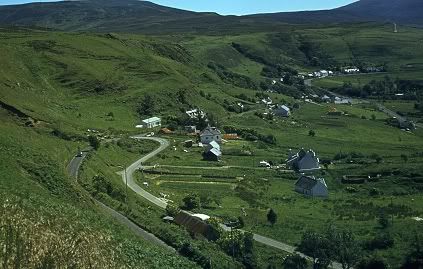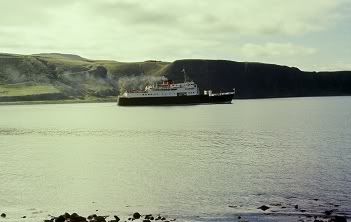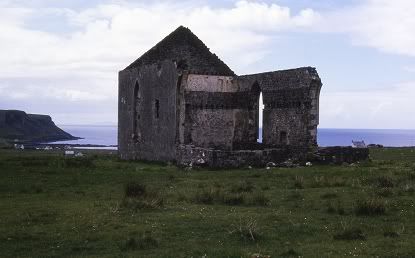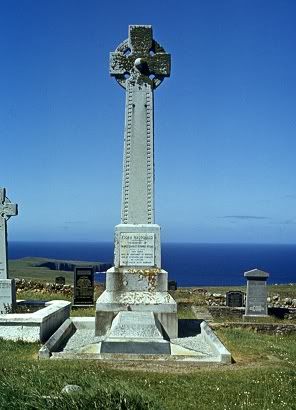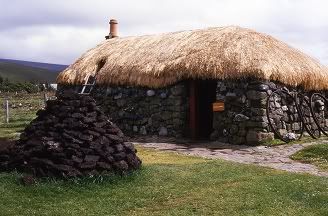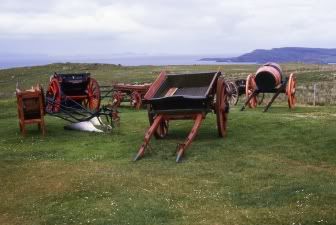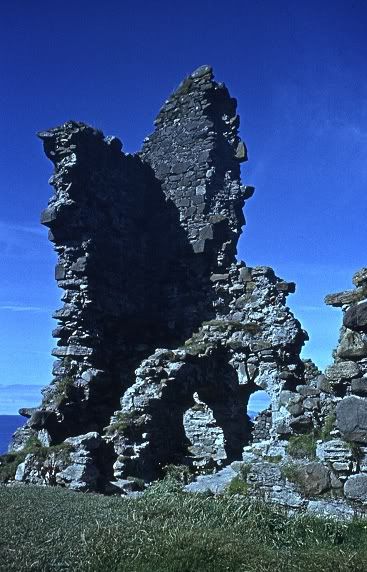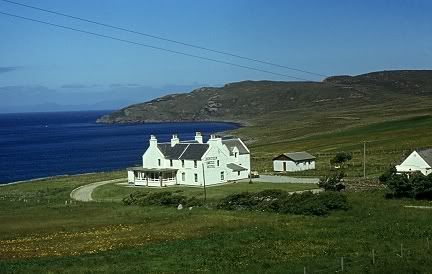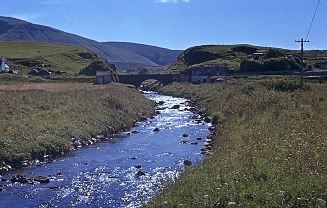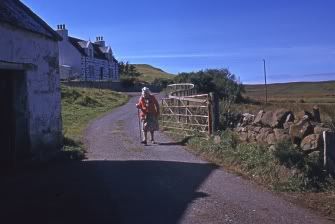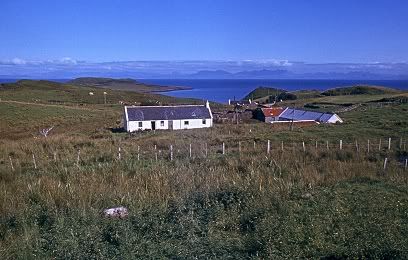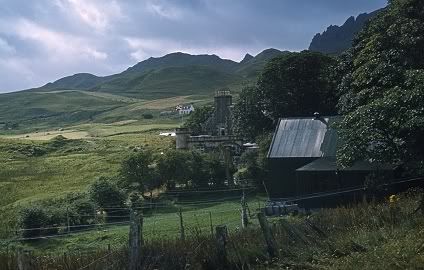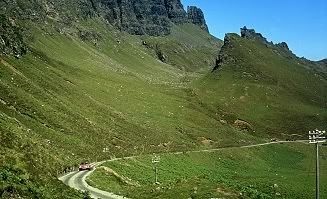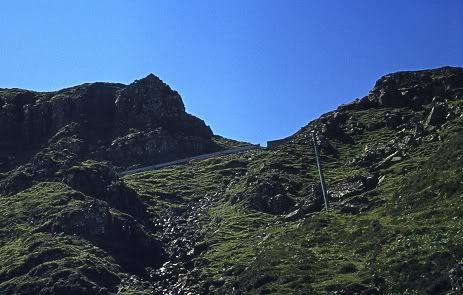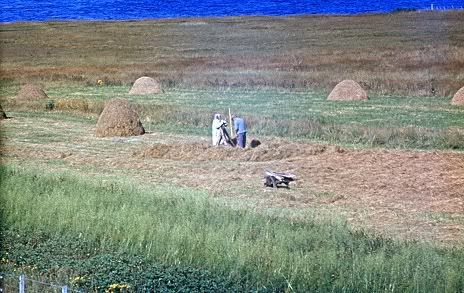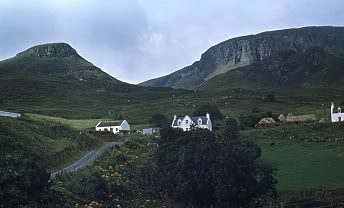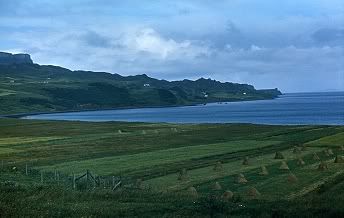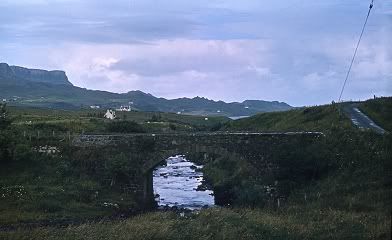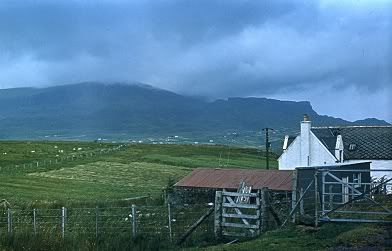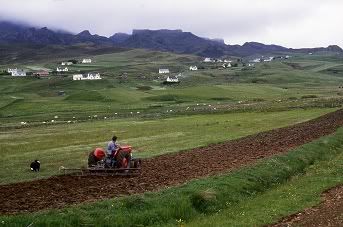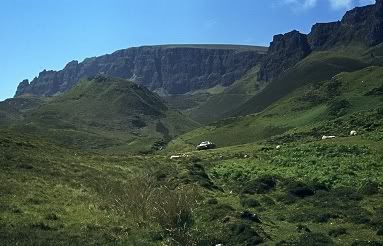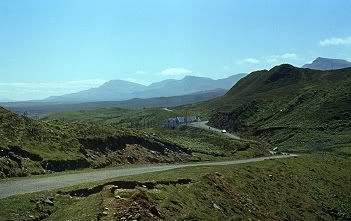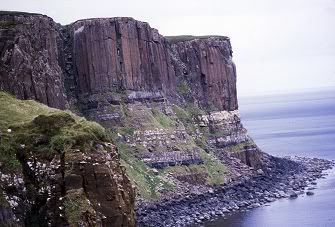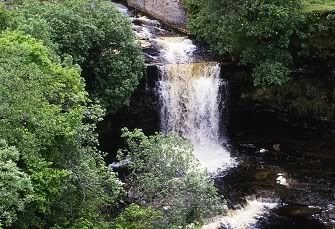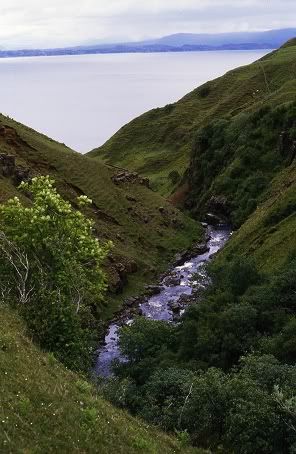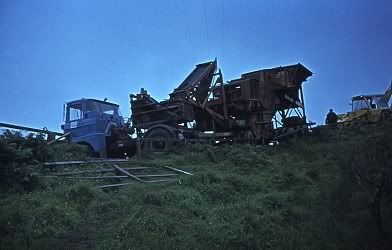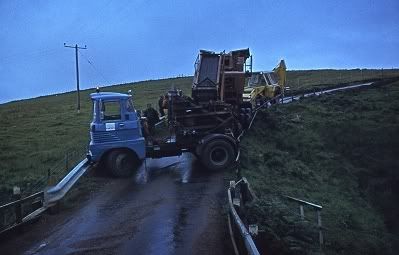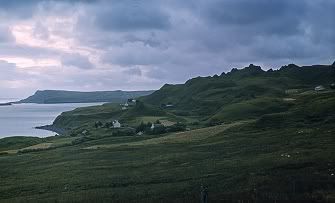AN T-EILEAN SGITHANACH
(The Isle of Skye)Page 3 of 4
DUNVEGAN TO CARBOST (For Uig and Portree)
The road continues to Claigan and is rather sparse, but with grand views across the Minch. Returning to the village the road turns northward (A864). Just a mile or so beyond you reach 'Fairy Bridge' where you will have heard from the castle guide is where the clan got the Fairy Flag (on show) which was supposed to have helped the Clan in battle. There is a triangle junction here. The simple 'Arched' bridge lies in a dip. If you didn't know its history, would simply pass by without giving it any thought.
The B864 to Lusta, sheltered in Loch Bay and a 'C' road continues a few miles via the tiny hamlets of Hallin and Halistra before terminating at Trumpan (Ardmore Point) on the Vatternish Peninsula. (Ard = High, More = Great) i.e. The great hights or Aird. The ruined church at Trumpan is where an incident took place in 1578 between the McDonalds and the Macleods and concluded in the "wall of blood", where the murdered were thrown in a ditch and covered by the stone wall, having first been locked in the church which was then set on fire. It stands in Skye peoples' memories as strongly as the slaughter at Glen Coe.
The single-track road wanders over the Geary (Cutting), with little of interest except nice sea views across to Harris and Lewis and Loch Snizort to Uig. The place names in Vaternish and Trotternish are a mixture of Gaelic and Norse. Vater would be `Water` and Nish/Ness, a point or promontory.
The A850 road, now mostly rebuilt, brings you to neat, little Edanbane, with its Pottery Crafts shop worthy of a wonder around.
From here the now bare landscape becomes more leafy and pleasant past Flashader and Treaslane to Bernisdale village. A short road turns inland down Glen Bernisdale at the edge of loch Niarsco. About a mile on and you come to Tayinloan Lodge with it's well groomed gardens.
On the Glen Bernisdale road by Tayinloan GardensAt Skeabost the Red Burn river falls below the road but has now lost most of its impact due to the new road which removed the old 'arched' stone bridge. You can still see the fall of water but it isn't as impressive as it was. It runs into Loch Greshornish. This was the sight of a battle between the MacLeods and MacDonalds in the 16th century.
Then you reach Carbost (the second so named i.e. as with Uig, are common Gaelig names). Carbost means the dwelling on the twist/turn of the road. Bost is Norse for a dwelling or hamlet. Sometimes pronounced Bor-st. It lies on the road triangle junction with Portree and Uig.
CARBOST TO UIG
It is only seven miles to Portree but unless you want to go there directly the B856 continues north to Uig (12 to 14 miles). Following Loch Snizort Beag via Kensaleyre and, Kingsburgh, which was named after Prince Charlie, who stayed there on his return to France, assisted by Flora McDonald who married the owner of Kingsburgh house.
Just past Kensaleyre as you pass loch Eyre between the road and the loch, are two standing stones, in a field.
Beyond Kingsburgh a short road turns inland to Peinlich down Glen Hinnisdale. In past Earlish, and above Uig bay with its grand view across to Uig village where the ferry plies to the Outer Hebridies.
Uig: means a 'Bay' and in northeast mainland is spel't and pronounced, as 'Wick'. This came about after Culloden and during the Highland Clearances, when many Gaels moved to the eastcoast but were not allowed to use their native language, or wear tartan. Uig is pronounced OO-IK, hence the Anglo corruption Wick, in the east. Other place names in that area can be matched to the Gaelic equivelent.
Uig is very Norwegian in appearance. It is from here that McBraynes ferries plies too and from North Uist (Loch Maddy) and Harris (Tarbert). For a pleasant day's sail you can take the ferry on the full triangle without getting off the boat. There is a good restaurant and bar on the ferry and I have always found the food very good, and the crew very friendly.
The Ferry Boat Inn is very pleasant and there is a nice restaurant, beyond the garage at the entrance to the pier, with large picture windows. I should add that at the summit of the Portree road (A856) there is a parking place where there is a modern version of a Broch overlooking the village and pier which makes a pleasant stop. The wooden church on the right hand side of the road is also very Norwegian in appearance. When a ferry is in port this makes an excellent picture spot.
From the Ferry Inn, about ¼ a mile (not the first opening) a short dead end road goes to Balnaknock (Wall of rock) in Glen Connon, a nice spot for an early morning or evening walk alongside the river Connon, about 10 miles. It ends in an eerie mixture of jagged peaks and a small loch.
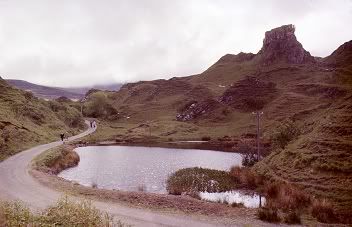
Walking in Glen ConnonThe first opening by the Inn is a long boring bit of road where the mountains close in sharply and give no space for any worthwhile view, though they can look quite broody on a misty day. The Glen then opens up with a very attractive corner by a small loch and rugged mountain tops.
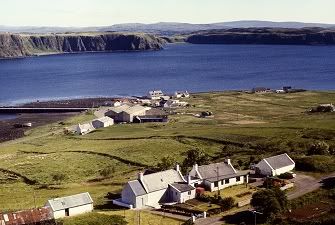
Uig village and Peir, over looking Loch Uig from the summit of the Kilmaluig road
Uig Village from the Kilmaluig road summit
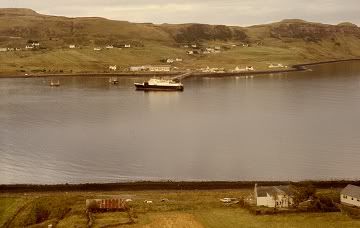
The ferry 'Hebridies' waits at Uig Peir. 'Hebridies departs for Lochmaddy, South UistSee pages 'Uig To Lochmaddy' South Uist
UIG TO PORTREE VIA KILMALUAG (Trotternish Peninsula)
To leave Uig the A855 road (northwards around the Trotternish Peninsula) branches off to the left just before you carry on to the pier head. It does a double twist and climbs steeply to the summit with a grand panorama overlooking the village and Loch. There is parking and a picnic area with seating. Mostly a quiet panorama but interesting when the MacBrayne's ferry is either entering or leaving the port as you look down on the activities.
A secondary route, in fact the shortest, to Staffin and Portree, cuts across country with magnificent mountain views and a steep gradient through the Quiraing Mountains with their jagged pinnacles of basalt rock. There is an air of a mini Glen Coe about the view from the summit as you look down on traffic winding down the glen below the jagged peaks.
However, we continue north past the tiny dwellings of Totscore. Between Liniero and Balgown a short road to the left takes you to Monkstadt House an attractive ruin, which overlooks Kilbride point on Loch Snizort, where Prince Charlie was assisted by, Flora MacDonald. The road is very poor and boggy and should be walked.
A quarter mile on in the same area as Monkstadt house is the ruins of St. Columba's Kirk, which looks rather forlorn.
Ruines of St. Columba's Kirk at MonkstatFrom Kilvaxter post office with continuous sea views to the outer isles over Camus Mor and Lub Score Bays. A short diversion can be taken to the pier (of a sort) at Bornesketaig, with Lord MacDonald' table (Island) just off the bay. But continue on the main road and you very quickly come to Flora McDonalds monument at Kilmuir, a high Celtic cross in the graveyard behind the folk museum (another blackhouse). The inscription on the monument was composed by Dr. Samuel Johnson. Flora died in 1790.
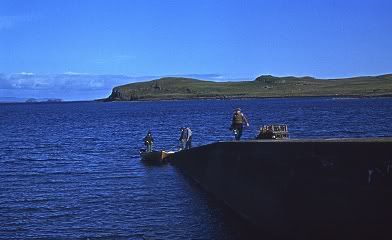
Fishermen at Bornesketaig arriving at the pier with their catch. Treshnish Isles and Harris & Lewis in the background
Flora MacDonald's grave at KilmuirOn the left of the road there is a car park, a large gift shop and a small cafe. The monument overlooks South Uist where Flora was born at Howmore.

The Folk Museum at KilmuirBeyond, the road then curves northeast around Score Bay where large boulders have, and still are, falling from the hills and are scattered everywhere. Beyond are the ruins of Duntlum castle, (well worth a short visit) a short walk from the road and high on the cliff top. Below the castle you can still see the score in the rocks where the long ships were hauled up to the dry ground. A very pleasant spot, indeed.
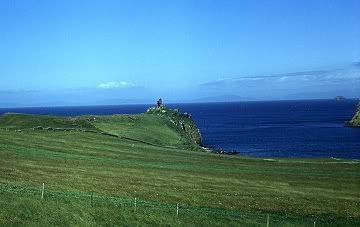
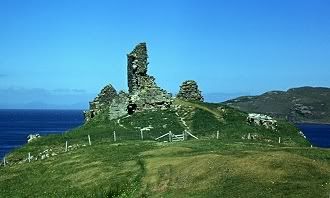
Ruin of Duntulm Castle with Harris and Lewis (Outer Hebridies) in the background
A short distance to the north a side road on the left takes you to Duntlum Hotel (pronounced Dun-tul-em) set below the castle on a very green fertile peninsula. A short stay for tea or coffee is rewarded with a grand view to the Outer Hebridies and the Trentnish Isles.
Duntulm Hotel by Duntulm Bay
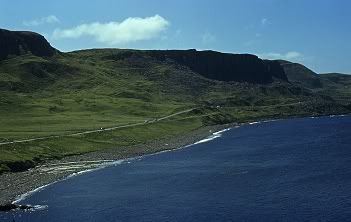
Coastal road at Duntulm Bay and the aftermath of a fatal road accidentThe coastal road around Duntulm Bay. It can be very dagerous as it climbs and winds it way around the headland. During one visit I came across a very sad incident when two teenagers from Portee High School were killed when their car went over the cliff edge, after a night of celebrations. It had been a very wild, stormy night.
In fine weather this is a most attractive area as these following pictures prove. However, the terrain should not be taken for granted.
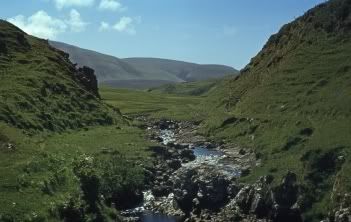
Warm sunny weather and grand countryside Between Duntulm and Staffin
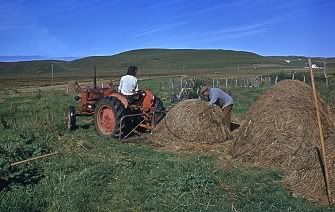
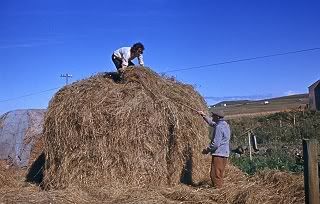
Working on a farm near Staffin
A fine clear view from Kingsbrough to the CuillinsOn now to Kilmaluag and another church at Flodigarry and another hotel and behind it a house called Flora McDonalds House; but it is obviously far too modern. It is thought the group of cottages were built on a site of a house where she once dwelled.
Kingsborough House. Where Bonnie Price Charlie stayed during the 1746 conflictFrom here the scenery changes quite dramatically and the high hills becomes jagged mountains and very bare, then around Staffin Bay (Staffin Island) to the road junction at Brogaig, with the secondary 'scenic' road from Uig. This is a very picturesque corner worth a picture or two, whether of the Quiraing mountain range or, out over Staffin bay.
If you haven't time to do this circular route, have a trip from here into the Glen and up the heavy gradient to the summit then return back to Staffin; it is well worth it. On a fine day there are some lovely views across the mainland of Sutherland and to Redpoint near Loch Torridon. Out in the Sound of Raasay between you and the mainland are the islands of Rona and the larger Raasay, recognised by its main peak, Duncaan (1455').
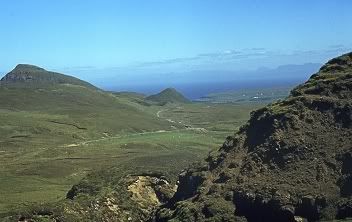
The steadily climbing road through the picturesque Glen
A car can just be seen on the final 1 in 10 climb to the summit
A view of this secondary road as it drops down to DunveganIn late summer Staffin is busy as farmers cut and build numerous hay stooks (stacks) and well worth watching for if you want to catch some pictures of rural life.
But of Staffin over a cow ramp, past Staffin Hotel and a mile or so on by a gated path and a small Loch on your right is Loch Mealt. The water runs below the road and about 100 yds on drops straight over the cliff with about an 800ft fall. The cliff edge here is very brittle so take great care and don't cross the markers. A full view is seen a little further south. The fall varies with the weather.
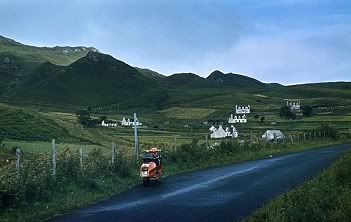
On the southern approach to Staffin Village (my 150cc Lambretta)
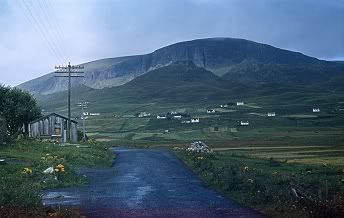
The village is widly scattered on the hillsides. Staffin Bay at Harvest Time
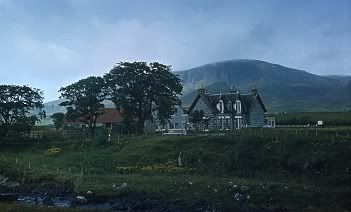
Staffin Hotel. Twisting, narrow bridge as the river runs into the bay
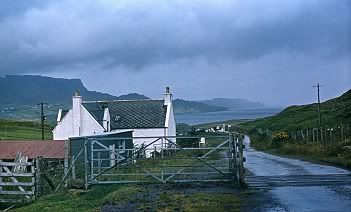
The Cattle Ramp as you enter Staffin from the south
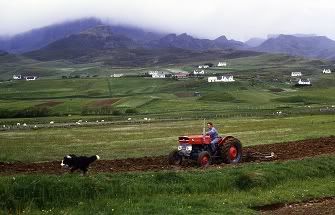
Ploughing at Staffa
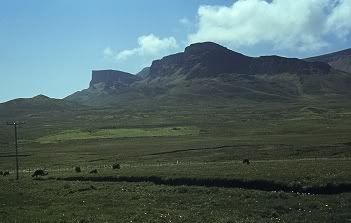
The Quaraing Mountains, on the way from Staffin to Portree
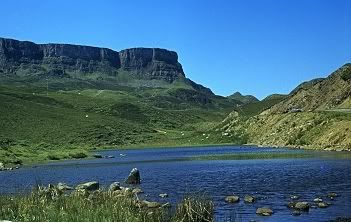
Views on the road from Staffin to Kilt Falls and Lealt Falls, which flows from the Lochan on the rightLook back northwest along the coastline and you see 'Kilt Rock' a great cliff of red basalt which has the appearance of pleats in a kilt and even has the cross markings of plaid (tartan). The coastline is crumbly and slippy and care should be taken.
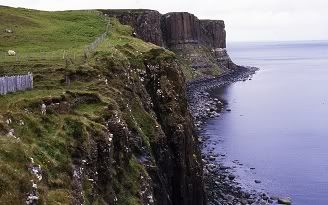
Kilt RockOnward a couple of miles past Valtos and you come to a summit by quarry workings. The road drops steeply and crosses a bridge on a tight curve then climbs again. It doesn't seem very impressive. But stop before reaching the bridge (on the decent) and walk over to see the great cavern where the river Lealt, below the bridge, falls on a double fall, 3-400ft below, again the flow varies according to the weather. A walk to the top of the cliff brings further grand views to the mainland. Portree is 7-8 miles on.
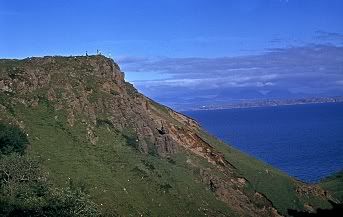
View From Lealt Falls. Mountains of Sutherland in background. Lealt Falls
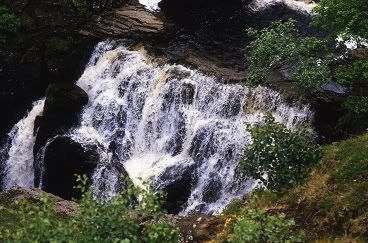
Lealt Falls after heavy rain
The falls drops as a stream into the sea, with the thin arm of
Duncann Island between the mainland, in the distanceOne time when travelling north from Portree I had to stop short of the bridge as a large truck hauling a 'digger', which was also chained to a tractor, behind it was being transported towards Portree. They had come from the quarry at the top of the road. As the truck reached the bridge, it couldn't hold the digger back and the rear tractor couldn't restrain it either. Both the truck and the digger twisted and ran into the side of the road and fencing, being completely locked in that position. Much further and they would have plunged down the ravine. I got a few interesting pictures of the event, but had to give up plans to travel around the Peninsula and returned to Portree and take another route for the day. The road was clear when I next passed it some hours later.
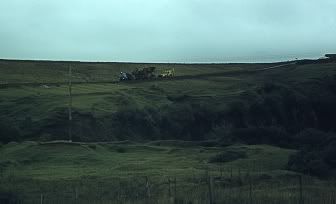
A truck body at the head and a tractor at the tail. The load creeps slowly down the grade
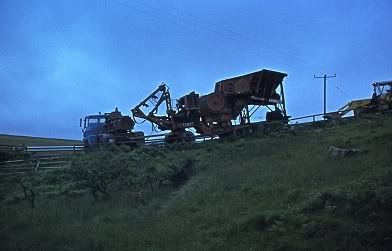
On the approach to the bridge over the falls the weight twists the cab around
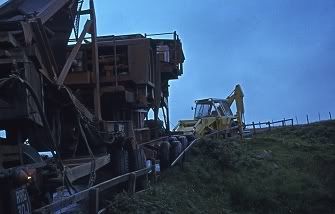
The flimsy fence snaps but the heavy machine just manages to stop going over the side of the roadSouth of the river Mealt the scene changes drearily for a spell but then on the right the hills start to dominate the scene and suddenly look down menacingly. You are facing the Storr mountain range (2358').
The Old Man of Storr: sticks up like a great thumb 160ft high and about 2-300 feet above the road. It is well worth spending time walking up to the rock. There are posts marking the route, the last 50-80ft being almost a scramble. But the scenery around the rock is the nearest you will ever feel to having been on the moon, anywhere in this country. There is a cave three parts up the rock and it has only been climbed once. The basalt rock is very crumbly and you should take care on the last leg of the climb. The view from the rock is memorable. Don't forget your camera.
The first loch by the road is Loch Leathan (The broad Loch) and terminates at the cliff top where it drops into Bearreraig Bay and has been developed into a hydro generating station. This supplies the island at normal times but there is an underwater cable from the mainland for emergencies. A little way on you can see the large water pipes going down the cliff face.
The next is Loch Fada (long loch) where normally you can see small boats dotted around with people fishing from them.
The Old Man dominates the skyline all the way to Portree and for two or three miles beyond. Just north of Portree, on the outskirts, the river Chracaig, at times, can produce some pleasant falls but is mostly hidden below road level.
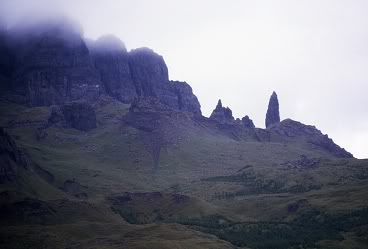
The Quiraing and the Old Man Of Stoer
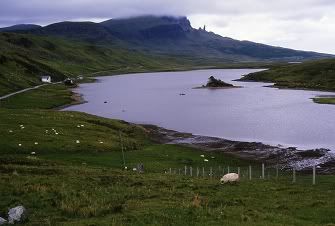
View from Loch Fada, north of Portre The Old Man of Stoer stands out like a thumb
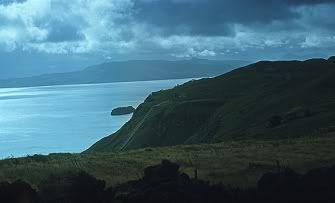
The Lealt Hydro Plant. The coastal road from the Staffin to Portree
